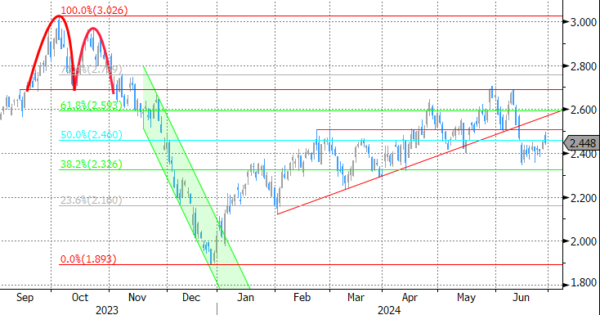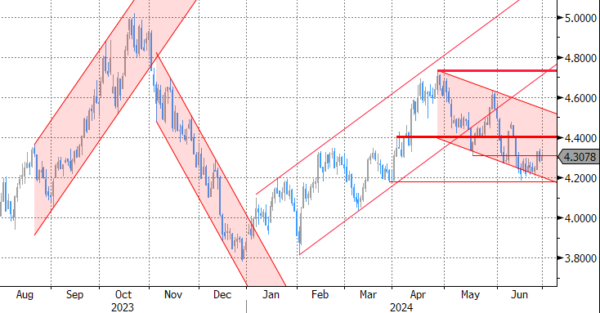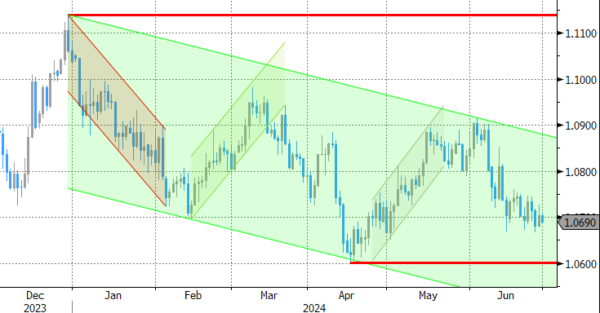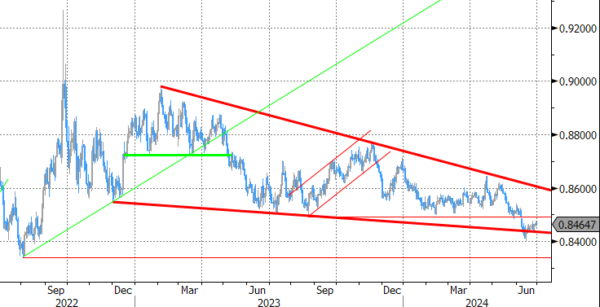Markets
The US Treasury sell-off from Tuesday and especially Wednesday, ended with the early US eco data yesterday. Disappointing and weak durable goods orders (especially the series used for GDP calculations) and a significant downward revision for personal consumption (1.5% Q/Qa instead of 2%) in the final release of Q1 GDP directed a bid into Treasuries. The final US debt sale of the week ($44bn 7-yr note auction) was strong and offered no way back for US T’s. Overnight, they showed some marginal signs of weakness again during the Biden/Trump debate. The onus wasn’t on atmospheric fiscal trajectories (as warned by the IMF as well; see below), but on Biden’s (physical) performance. It seems that the president was thrown under the bus. A dismal performance in the next election poll could pave the way for eventually putting someone else’s name on the Democratic ticket.
US May PCE deflators today kick-off a string of important US eco numbers. Following earlier released CPI data, we can expect a benign outcome. Headline and core CPI respectively were flat and 0.2% higher on the month, coming in below consensus and significantly slowing the paces recorded in the first four months of the year. Personal income and spending data are also worth watching. Especially spending given recent weakness in retail sales. Data might thus be supportive for US Treasuries and core bonds in general. Some final end-of-quarter repositioning and a preference to err on the safe side going into this weekend’s first round of French parliamentary elections also support that view. The combination of both suggests that USD losses in case of weaker figures could be balanced by both euro caution and a tricky risk sentiment. After today’s PCE deflators, ISM surveys, ADP employment change and US payrolls are lining up next week. Following some labour market warnings by top Fed officials this week (Daly, Cook), risks turn asymmetric for the labour figures with any signs of weakness likely resulting in markets pushing harder for a September rate cut and a faster path downward in 2025. National EMU CPI data (France, Italy, Spain) will set the tone for EMU figures out Tuesday.
News & Views
The Czech National Bank yesterday cut its policy rate by 50 bps, bringing the two-week repo rate at 4.75% with 5 members supporting the decision while two MPC members preferred a 25 bps reduction. Analyst expectations in the run-up to the meeting also split between continuing with a 50 bps or downscaling to a 25 bps cut. The CNB indicated that the fight against inflation isn’t over even as it started lowering rates. Policy must remain tight to keep inflation close to the target in the long term. After yesterday’s decision, real yields remain significantly positive, dampening inflation. Czech inflation returned to 2% in February and since moved back up in the upper halve of the 1% tolerance band around the 2% target. As rates gradually approach neutral levels, the CNB will likely slow the pace of moderation of policy restriction at the meetings ahead or keep rates unchanged for some time if necessary. The MPC will base its decisions on an assessment of newly available data and their implications for the inflation outlook. Markets interpreted the decision as tilting to the dovish side. The Czech 2-y swap yield declined 6 bps. The Czech koruna weakened from near EUR/CZK 24.91 to close the session at 25.06.
In a regular review under an article IV consultation, the IMF assessed that the US economy has proven to be robust, dynamic and adaptable to changing global conditions. Activity and employment continue to exceed expectations and the disinflation process has been considerably less costly than many had feared. At the same time, the Fund concludes that the fiscal deficit is too large, creating a sustained upward trajectory for the public debt-GDP ratio. Specifically, under current policies, the general government debt is expected to rise steadily and exceed 140% of GDP by 2032. To put debt-to-GDP on a clear downward trajectory, a frontloaded fiscal adjustment will be needed that shifts to a general government primary surplus of around 1% of GDP (an adjustment of around 4% of GDP relative to the current baseline). In order to reach this, policies will need to go beyond finding efficiencies in discretionary, non-defense federal spending. Policymakers will need to carefully consider raising indirect taxes, progressively increasing income taxes eliminating a range of tax expenditures, and reforming entitlement programs, the Fund assesses.
Graphs
GE 10y yield
The ECB cut its key policy rates by 25 bps at the June policy meeting. A more bumpy inflation path in H2 2024, the EMU economy gradually regaining traction and the Fed’s higher for longer US strategy make follow-up moves difficult. Markets are coming to terms with that. For the time being, though, the political narrative (France) dominates. After hitting a new YtD top at 2.7%, the German 10-yr yield corrected lower on safe haven bids.
US 10y yield
The Fed is seeking more evidence than just one slower-than-expected (May) CPI is providing. Upgraded inflation forecasts and a higher neutral rate complicate the exact timing of a first cut further. June dots suggest one move in 2024 followed by four more next year. Markets are positioned more aggressively, turning the recent low in yields into a technical support zone. The US 10-y yield is testing the downside of the 4.2/4.7% trading range.
EUR/USD
EUR/USD is stuck in the 1.06-1.09 range. The desynchronized rate cut cycle with the ECB exceptionally taking the lead, strong US May payrolls and a swing to the right in European elections pulled the pair away from 1.09 resistance. The Fed meeting balanced the weaker than expected US CPI outcome. Euro fragility makes a return to the 1.06 downside more likely than not.
EUR/GBP
Debate at the BOE is focused at the timing of rate cuts. May headline inflation returned to 2%, but core measures weren’t in line with inflation sustainably returning to target any time soon. Still some BoE members at the June meeting appeared moving closer to a rate cut. This might cap further sterling gains. At the same time, the euro remains vulnerable to political event risk going into the French elections. EUR/GBP 0.84 is becoming solid support.















